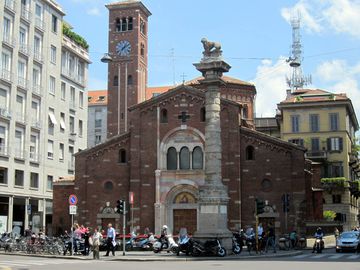

Saint Babylas had been Patriarch of Antioch in present-day Turkey before dying in prison in 253 AD during the Decian persecution. Three years earlier Emperor Decian had obliged everyone in the Roman Empire to perform a sacrifice to the Roman gods and the health of the Emperor. Those who refused - and they were not necessarily Christians - were killed or thrown in prison for life. But that was not Babylas's only crime: he had also prevented the previous Emperor, Philip, who had blood on his hands, from entering a Christian temple during Easter Vigil.
Babylas is considered the first saint whose remains were moved, or translated, to use a religious term, from one place to another. It was Milanese Bishop Marolus who brought the saint's remains to Milan from Antioch in the 5th century. The Bishop had also brought the remains of Saint Romanus of Caesarea and built the Church of San Romano, which stood just a bit south of the Church of San Babila, being the principal church in the neighborhood until the 19th century when it was demolished.
The first Church of San Babila was built at the end of the 11th century and was enlarged five hundreds years later, receiving an elaborate baroque façade. The entire structure was then renovated in the 19th century and in the 20th the baroque façade was taken down and replaced with a Neo-Romanesque one by architect Paolo Cesa-Bianchi. The present bell tower was erected in 1920 - the original had collapse in the 16th century.
Inside the church very little has remained of the original structure, just the 6th-century stone slabs on the right wall by the entrance and some 11th century capitals. The three naves are separated by pilasters with semi-columns, which support a groin vault in the central nave and a barrel vault on the lateral naves. The fresco in the apse depicting St Babylas and three boys who were martyrized with him was created in 1890 by Luigi Cavenaghi.
The Church of San Babila played an important role during the Five Days of Milan uprising in 1848, which resulted in the death of 600 Milanese. It was from here that the citizens charged at the Government Palace in Corso Monforte demanding a civic constitution.
The column with a lion on top in front of the church was placed in its current position in 1650. Most likely, it had been a gift from the Republic of Venice after one of the numerous peace deals signed between the two armies. However, a legend says that it appeared there on its own after the Milanese once prevented the Venetians from entering and occupying the city.